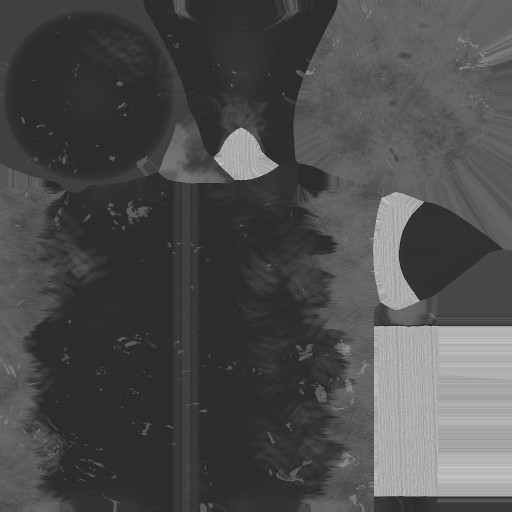3D Facebook posts: what and how
Facebook developers recently announced support for 3D posts. That is, now any user can easily download a low-poly model in the right format (see below), supply it with text and show it to friends and acquaintances.

Here is how it looks like ( link ):

')
Understandably, in most cases, this opportunity will be used for advertising, product presentations and other commercial purposes. I think the marketing departments of all large companies have already adopted this technology and are actively experimenting with the creation of powerful 3D scenes. However, they clearly do not like the list of restrictions that the developers rolled out:
However, this is no longer a bad thing, especially considering that you can use the PBR model for rendering materials.
When the power of graphics processors has grown to sufficient values, programmers decided to use physical laws more often when calculating the illumination of three-dimensional objects in real time. One of the models of such illumination involves the simulation of the surface using three values: diffuse reflection / refraction, metallicity and roughness. In order not to go into a long explanation, I will give textures that show how the above model is reproduced.
Diffuse reflection / refraction map. It determines how light is diffused in the thickness of the material. In fact, it determines the color of the model (do you recognize the teapot?):

Metallicity card. In places where the material behaves like a dielectric, the metal content value is minimal, where the metal is maximum:

The roughness map, everything is also quite simple here: the smooth surface has the minimum value, the rough surface has the maximum:

Why did I bring all this? The bottom line is that this is all that is required for the correct description of the material! The cards themselves are prepared in a 3D editor and exported to glTF in one click. All the rest will be done by algorithms that will take them into account to calculate the physically correct lighting of the model.
Good news, the three-dimensional engine is not needed. Facebook developers have already deployed the latest version of the Three.js engine at their facilities, all you need is a model. The bad news is that most three-dimensional editors do not support exporting to glTF.
Nevertheless, on the official page of the standard glTF you can find two dozen solutions that can be used with varying success for the preparation of models. They can be divided into two categories: converters (from OBJ, FBX, COLLADA, etc.) and plug-ins for simulation packages / engines, while there is only Blender, 3ds Max and Unity.
In general, look for yourself. For the above kettle, the following tools were used: modeled in 3ds Max, the textures for the material were baked in Substance Painter, the final export to glTF was produced by the Verge3D plugin.

Here is how it looks like ( link ):

')
Understandably, in most cases, this opportunity will be used for advertising, product presentations and other commercial purposes. I think the marketing departments of all large companies have already adopted this technology and are actively experimenting with the creation of powerful 3D scenes. However, they clearly do not like the list of restrictions that the developers rolled out:
- Supports glTF 2.0 format and only it;
- The maximum size of the model with all the textures is 3 MB;
- the sizes of all textures must be a power of two, that is, 1024x512 will pass, and the sizes loved by many 1000x1000, 2000x2000 anymore;
- lighting sources, camera, background and many other things will not work out.
However, this is no longer a bad thing, especially considering that you can use the PBR model for rendering materials.
PBR rendering
When the power of graphics processors has grown to sufficient values, programmers decided to use physical laws more often when calculating the illumination of three-dimensional objects in real time. One of the models of such illumination involves the simulation of the surface using three values: diffuse reflection / refraction, metallicity and roughness. In order not to go into a long explanation, I will give textures that show how the above model is reproduced.
Diffuse reflection / refraction map. It determines how light is diffused in the thickness of the material. In fact, it determines the color of the model (do you recognize the teapot?):

Metallicity card. In places where the material behaves like a dielectric, the metal content value is minimal, where the metal is maximum:

The roughness map, everything is also quite simple here: the smooth surface has the minimum value, the rough surface has the maximum:

Why did I bring all this? The bottom line is that this is all that is required for the correct description of the material! The cards themselves are prepared in a 3D editor and exported to glTF in one click. All the rest will be done by algorithms that will take them into account to calculate the physically correct lighting of the model.
What to do
Good news, the three-dimensional engine is not needed. Facebook developers have already deployed the latest version of the Three.js engine at their facilities, all you need is a model. The bad news is that most three-dimensional editors do not support exporting to glTF.
Nevertheless, on the official page of the standard glTF you can find two dozen solutions that can be used with varying success for the preparation of models. They can be divided into two categories: converters (from OBJ, FBX, COLLADA, etc.) and plug-ins for simulation packages / engines, while there is only Blender, 3ds Max and Unity.
In general, look for yourself. For the above kettle, the following tools were used: modeled in 3ds Max, the textures for the material were baked in Substance Painter, the final export to glTF was produced by the Verge3D plugin.
Source: https://habr.com/ru/post/350090/
All Articles